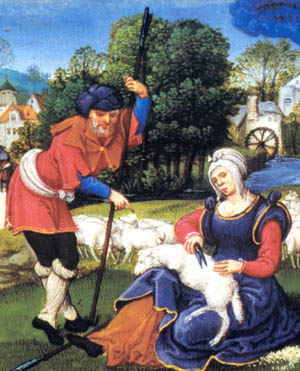 |
Catholic Customs
A Study of the Veil in the Christian Tradition - Part 5
The Veil in St. Thomas Aquinas’ Commentary on the Corinthians
Donald P. Goodman III
4.1.2 St. Thomas Commentary on the Epistle to the Corinthians
St. Thomas analyzes the subject of the veil at much greater length, in his great commentary on St. Paul’s letter, the Supra I Epistolam B. Pauli ad Corinthios lectura, (1) which I will refer to as the Supra from now on. The Supra is St. Thomas’s commentary on I Corinthians.

A farmer and his wife shearing sheep
Book of Hours, Italo-Flemish, early 16th century |
The third verse of Chapter 11 of this Epistle is this:
“I would have you know, that the head of every man is Christ; and the head of the woman is the man; and the head of Christ is God.”
St. Thomas analyzes this text primarily as an expression of lofty mysteries, discussing first and foremost the relevance of the verse for Christology. (2)
He does, however, briefly turn to the analogy’s relevance to man and woman, interpreting it similarly to the way I interpreted it in the last article [click here], though with an added element which gives the analogy even more beauty. St. Thomas holds that man and woman also represent two sides of human reason, saying:
“We are able to expound mystically on what is said: the head of the woman is the man, and the head of the man is Christ. [It is said that] through the woman, sensibility might be understood; that is, that we might understand the lesser part of reason which is occupied with temporal cares; but through man we understand the higher part of reason which is raised to divine and spiritual contemplation.” (3)
St. Thomas adds that “Christ is the head of all inasmuch as we love Him and work virtuously, and are raised and helped to the contemplation of God.” (4) This interpretation is completely in line with the divine analogy outlined in previous sections (5) and is expounded for similar reasons.

Young woman wearing a white wimple
Rogier van der Weyden, Flemish, Staatliche Museum, Berlin |
St. Thomas does not waste any time explaining the reason for St. Paul’s veil legislation, explaining matter-of-factly that “the covering of the head is like the overshadowing of the power of the man.” (6) He justifies the necessity of this “overshadowing” based on his particular version of the analogy that I have found constantly throughout the History of the Church, in which man and woman are compared to various aspects of the divine truth.
He explains that the “overshadowing” for the man is not suitable because “the head is the glory of man.” (7) If a man covers his head while praying or prophesying, he “shows a subjection which is against freedom.” (8) It is not proper for a man, who represents the higher part of reason according to St. Thomas’s exegesis on verse 3, to be subject to woman, who represents its lower part; rather, it is proper for a woman to be subject to man, just as the lower part of reason is subject to the higher. “To cover the head,” St. Thomas teaches, “is to overshadow [with] power.” (9) So, covering the head is an unsuitable gesture for a man, but a suitable one for a woman. (10)
St. Thomas then turns to verse 5, in which St. Paul proceeds to the woman and states that her head should be covered.” (11) His reasoning is brief and precise: “And the cause of this is that woman is naturally subject, but man presides. Whence just as a man ought not to cover his head, so also a woman ought neither pray nor prophesy with her head uncovered ... for it is one as if she were shaven.” (12)

Portrait of a Woman displays a conventional medieval beauty and headdress
Rogier van der Weyden, National Gallery, London |
The veil is the sign of man’s authority over woman, and consequently of Christ’s authority over the Church , and of so many other things. Consequently, the Apostle commands women to cover their heads.
St. Thomas also explains that while women wearing their hair long and men wearing it short is a natural reminder of the mentioned divine truths, the veil is still necessary. For women, the natural veil – that is, her hair – is not enough to cover her head. He explains, “There are indeed natural veils on the head such as the hair.” (13) And he gives a good reason why it should be covered: it is to avoid a display of fashion and vanity. In fact, he teaches: “Woman naturally nourishes her hair, therefore she naturally ought to completely cover her head.” (14)
St. Thomas also seems to confirm the reasoning of St. John Chrysostom requiring women to be covered at all times. Since St. Paul says that for women to be uncovered is equivalent to being shorn, I would ask if they should not use the veil all the times. St. Thomas agrees with St. Paul’s analogy. It has a great power of expression. Actually, what woman would like to present herself in public with her head shaved? So, if the analogy is correct when women pray and prophesize, why wouldn’t it also be applicable in their normal life?
Furthermore, St. Thomas explicitly declares that St. Paul is arguing that the head be covered from the tendency of human nature, and not from any human law or custom. In reference to women wearing long hair and men wearing short, St. Thomas argues that “this is not argued from the law, but from nature,” (15) saying that, while these customs do not come from natural law, they are the mores to which human nature tends. (16) He notes that in some countries, it is not the custom for women to grow their hair as long as it is in Europe, but he also notes that even in these countries, women have longer hair than men.
This tendency, then, is natural, even if it is not a natural law. St. Thomas then applies this argument to the veil, teaching that St. Paul’s “argument is thus: that which is naturally praiseworthy and glorious to her, she ought to take on. But it is praiseworthy and glorious for a woman to nourish her hair; and this [hair] means a veil on the head; therefore, a woman naturally ought to cover her head.” (17)
His argument sounds very like that of St. John Chrysostom, and certainly seems to imply, though he nowhere says explicitly, that women ought to keep their heads covered at all times. He is, at least, adamant that women ought to cover their heads at the very least in churches and while praying. (18) On that point, at least, all the great thinkers of Christendom have been explicitly united.

Biblical figures like Salome, above, were often shown wearing medieval dress
Martianus Capella, 15th century, Biblioteca Mariciana, Venice |
Finally, St. Thomas interprets verse 16: “But if any man seem to be contentious, we have no such custom, nor the Church of God.” He notes:
“Therefore he [St. Paul] says: You know the reasons why a woman ought to cover her head. But if anyone is contentious, that is, a disrupting challenger (for contention is a negation of the truth with a disruptive arrogance that must be shunned), it should suffice to refute him to say that we,Jews, believers in Christ, do not have the custom, that women should pray without covering their heads, nor has the Church of God. For if the reasoning is useless to convince him, this custom should suffice, otherwise he would act against the custom of the Church.” (19)
Therefore, one sees that St. Thomas also defends that women should cover their heads while they pray, and that this is according to the custom of the Church.
4.1.3 Conclusion
St. Thomas’s opinions on the veil are entirely in line with those of the Fathers of the Church I have already examined. Indeed, in the Summa his argument is composed almost entirely of a quotation from St. Augustine, who clearly considered the veil to be an important element of the authentic female Catholic life. He explicitly requires women to wear it in places of prayer, whether they want to or not, saying only that they might be excused from sin if they are following some contrary custom. Such a regional custom, however, is not to be praised, and consequently it must be discouraged.
Table 3: The Fathers and Doctors: A Summary of Doctrine
|
St. John Chrysostom
|
St. Augustine
| St. Thomas
|
| 2-4 Scope |
All the hair
|
All the hair
| All the hair |
| Time |
At all Times
|
At all time
|
At all times |
| Reasons |
Div. anal.; lust |
Lust
|
Div. anal.; lust |
| Verse 16 |
Still bound
|
|
|
Furthermore, it follows logically from St. Thomas’s arguments that women ought (that is, it would be good for them) to wear the veil at all times. While he does not explicitly mention it, I can derive this principle from his argument in two ways. First, his argument almost exactly mirrors that of St. John Chrysostom, who stated in no uncertain terms that his argument required women to wear the veil at all times.
Second, his deferential reference to St. Augustine in the Summa indicates a complete agreement with the Doctor of Grace on the matter. It is my opinion that, as shown above, St. Augustine believed that a woman ought to wear the veil at all times. Since St. John Chrysostom’s claim seems to me correct, St. Thomas most certainly held that the veil should be worn by women at all times.
What, however, of the Church herself? Has the Church promulgated any rules concerning the veil? If so, what are they, and are they still in effect? I will examine in my next installment the history of the veil in ecclesiastical legislation, to help discern the mind of the Church on this matter which the quoted Church Fathers and Doctors held so important.

Posted May 27, 2005
Go to Introduction Part 1 Part 2 Part 3 Part 4 Part 6 Conclusion
1. St. Thomas Aquinas, Supra I Epistolam B. Pauli ad Corinthios lectura at http://www.unav.es/filosofia/alarcon/amicis/c1r.html, in Corpus Thomisticum, ed. Enrique Alarcón. Viewed on 27 April 2004. All translations from this work are the author’s.
2. Ibid., Versiculus 3.
3. “Possumus autem mystice exponere hoc quod dicitur: caput mulieris vir et caput viri Christus, ut per mulierem intelligatur sensualitas seu inferiorem intelligamus (partis) partem rationis quae occupatur temporalibus ministrandis; per virum autem superiorem partem rationis quae elevatur divinis et spiritualibus contemplandis.” Ibid., Versiculus 3.
4. “Et sic Christus est caput omnium in quantum per eum dirigimur ad virtuose operandum, et elevamur et adiuvamur ad Deum contemplandum.” Ibid, Versiculus 3. See particularly section 2.2, [click here] where we first touched on this great analogy.
5. “[V]elatio capitis est quasi obumbratio potestatis viri.” Ibid, Versiculus 4.
6. “[V]elatio capitis est quasi obumbratio potestatis viri.” St. Thomas Aquinas, Supra,
Versiculus 4.
7. “[Q]uia in capite est gloria viri.” Ibid.
8. “[O]stendit subiectionem quae est contra libertatem.” Ibid.
9. "[V]elare autem caput est...obumbrare potestatem.” Ibid.
10. Interestingly, St. Thomas here addresses whether a bishop praying in a mitre violates St. Paul’s ordinance. Without much fanfare, he decides that it is not: “Dicendum quod non, quia mitrum est indicia potestatis, velare autem caput est, sicut hic intendit apostolus, obumbrare potestatem.” Ibid.
11. “[P]rosequitur de muliere et dicit contrarium.” St. Thomas Aquinas, Supra, Versiculus 5.
12. “Et huius causa est quia mulier naturaliter est subiecta, vir autem praesidens. Unde sicut vir non debet velare caput, ita nec mulier non debet orare aut prophetare capite non velato...Unum est enim ac si decalvetur.” Ibid.
13. “Sunt quaedam velamina naturalia circa caput, sicut capilli, ...in supplementum naturalium.” Ibid.
14. “[N]aturaliter autem mulier comam nutrit, ergo naturaliter debet cooperire caput.” Ibid.
15. “[H]ic non arguitur ex lege, sed a natura.” St. Thomas Aquinas, Supra, Versiculus 14.
16. St. Thomas Aquinas, Ibid.
17. “Ratio sua talis est: illud quod naturaliter est laudabile et gloriosum alicui, debet ab eo fieri; sed mulieri est laudabile et gloria nutrire comam: haec autem significat velamen capitis; ergo mulier naturaliter debet velare caput.” Ibid.
18. “[N]on est dubitatio quod in loco orationis ubi sunt sancti Angeli, mulier debet velare caput in ostensionem suae conditionis: ipsi enim Angeli assunt nobis cum oramus.” Ibid., Versiculus 10.
19. “Dicit ergo: habetis, o Corinthii, per rationes quod mulier debet velare caput, sed si quis videtur contentiosus esse, idest clamosus impugnator: nam contentio est impugnatio veritatis cum confidentia clamoris et ideo fugienda est...si quis, dico, resistat rationibus contentiose, non poterit resistere consuetudini, quia nos, scilicet apostoli et Iudaei (quia ex Iudaeis sumus), talem consuetudinem, idest quod mulieres non velentur, non habemus, neque etiam Ecclesia Dei, quia neque secundum legem Moysi et secundum Christum est ut vir velet caput et non mulier. Et sciendum ex hoc quod, sicut dicit Augustinus, mos populi Dei pro auctoritate habetur, et propter hoc quilibet debet in his quae non sunt per se mala neque prohibita conformare se moribus gentis. Et ideo Ambrosius dixit Augustino: serva consuetudines Ecclesiarum ad quas ibis, in his tamen quae non sunt contra Deum.” St. Thomas Aquinas, Supra, Versiculus 16.
The pleasure TIA has to publish collaborations of our guest columnists does not imply that it endorses all the opinions expressed in their articles.
Return to TOP

Related Topics of Interest
 Restoration: Let's Begin with the Veil Restoration: Let's Begin with the Veil
 St. Pius X on Priestly Dignity and Propriety St. Pius X on Priestly Dignity and Propriety
 Titles and Signs of Respect for Priests and Religious Titles and Signs of Respect for Priests and Religious
 Why Shouldn't Women Wear Trousers Today? Why Shouldn't Women Wear Trousers Today?

Related Works of Interest
|
Catholic Customs | Religious | Home | Books | CDs | Search | Contact Us |
Donate

© 2002- Tradition in Action, Inc. All Rights Reserved
|
 |
|